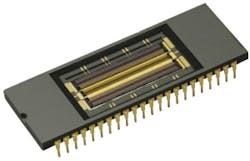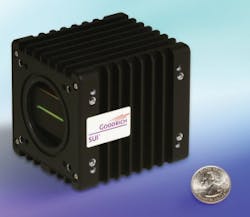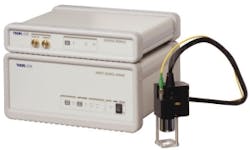IR image sensor
The G10768 series 1024-channel infrared (IR) image sensor is designed for OCT, near-IR (NIR) spectroscopy and foreign object screening—all of which require a multichannel, high-speed line rate. A signal processing circuit uses capacitive transimpedance amplifiers (CTIAs) to allow signal readout while simultaneously integrating signals in all pixels via sample-and-hold circuits.
Hamamatsu Photonics, Bridgewater, NJ, http://bit.ly/f8thNX
SWIR InGaAs camera
The SU1024LDH2 digital line scan SWIR indium gallium arsenide (InGaAs) camera features an increased line rate to over 91,900 lines per second for SD-OCT imaging applications to detect moisture, lipids, proteins, or other molecular vibration absorbance bands in the 800–1700 nm range. Wavelength response ranges from over 0.8 to 1.7 μm with a 25-μm pixel pitch and aperture heights of 25 μm or 500 μm.
Sensors Unlimited – Goodrich ISR Systems, Princeton, NJ, http://bit.ly/febaqv
MEMS swept source
The HSL-mini microelectromechanical systems (MEMS) scanner-based swept source scans at rates up to 50 kHz while maintaining a wide scan range over 160 nm for high-speed imaging or motion-sensitive optical coherence tomography (OCT), such as ophthalmology and endoscopy. An external cavity design with a diffraction grating maintains low relative intensity noise (RIN).
Santec, Komaki, Japan, http://bit.ly/e6fTrM
SS-OCT imaging system
A swept source optical coherence tomography (SS-OCT) imaging system incorporates a 55 kHz swept source laser with a center wavelength of 1325 nm to enable noninvasive, real-time imaging of highly scattering tissue at depths up to 6 mm. Features include high-performance software, a 3-D scanning probe, and a stand, the latter of which enables coarse and fine axial translation as well as rotation and translation of the sample in the X and Y directions.
Thorlabs, Newton, NJ, http://bit.ly/frJxGb
Supercontinuum fiber lasers
The SuperK EXTREME eco-system offers a product range spanning different spectra and power levels and an accessory portfolio that allows on-the-fly variation of repetition rate, flexible wavelength tuning systems and spectral shaping options for applications in optical coherence tomography (OCT), fluorescence microscopy, flow cytometry, fluorescence lifetime imaging (FLIM), fluorescence resonance energy transfer (FRET), and non-contact inspection.
NKT Photonics, Birkerød, Denmark, http://bit.ly/dSjPJW
SWIR line scan camera
The Lynx SWIR high-resolution InGaAs line scan camera features a 12.5 μm grid that offers 512, 1024 or 2048 resolution options, a frame rate up to 40 kHz, and high sensitivity mode (HS) to high dynamic range mode (HDR), the latter of which is well suited to optical coherence tomography (OCT). Its one-stage thermoelectric cooling expands to three-stage cooling for a higher signal-to-noise ratio, making it ideal for low light level applications such as Raman, emission or luminescence spectroscopy. Ambient operating temperature ranges from 0° to 50°C.
Xenics, Leuven, Belgium, http://bit.ly/frnLTd
Ti:sapphire oscillators
The Femtosource Synergy Ti:sapphire oscillators generate pulse durations from sub-10 to sub-20 fs. Average powers range from 500 mW to 1.2 W and pulse durations of sub-10 fs yield peak powers of over 1 MW for optical coherence tomography (OCT) and terahertz and ultrafast spectroscopy.
Femtolasers Produktions GmbH, Vienna, Austria, http://bit.ly/fNpMeB
Data acquisition board
The AXSUN DAQ data acquisition board has a 12 bit 500 MSPs front end configurable with either an external k-trigger or an internal trigger, and integrates with proprietary optical coherence tomography (OCT) swept sources. A Base Camera Link (CL) interface transmits OCT spectral data to image processing electronics. OCT applications include ophthalmology, cancer diagnosis, and pulmonary and gastrointestinal imaging.
Axsun Technologies, Billerica, MA, http://bit.ly/dM647k
SD-OCT software
CORDA software uses existing spectral-domain optical coherence tomography (SD-OCT) images to assist in diagnosing retinal and optic nerve disease such as glaucoma, and is said to detect them earlier. The software analyzes the internal structure of the retinal nerve fiber layer (RNFL) through discrimination of its different components, and works with all existing SD-OCT images.







